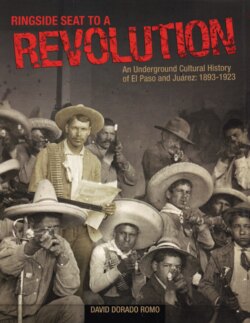Читать книгу Ringside Seat to a Revolution - David Dorado Romo - Страница 35
На сайте Литреса книга снята с продажи.
ОглавлениеLAURO AGUIRRE: THE EDITOR BEHIND A GREAT WOMAN
TERESITA’S REPUTATION AS a revolutionary
was in no small part due to Lauro Aguirre. He
believed Teresita Urrea was the only person who
could gather the people of Mexico behind her to
overthrow the brutal regime of Porfirio Díaz. Aguirre
was a sort of John the Baptist for Teresita—a voice in
the wilderness fervently disseminating the news of a
coming era of justice and equali-
ty that she was about to bring to
Mexico. The indefatigable El
Paso journalist was the agitator
for three major revolutionary
movements that were waged on
the border during the turn of the
century—Teresismo (1893-1896),
Magonismo (1906-1911) and
Maderismo (1910-1911).
For the most part, students
of the Mexican Revolution have
ignored Lauro Aguirre’s seminal
role in helping spark the revolu-
tion. He didn’t fit neatly into any
ideological current and historians
usually don’t know what to do
with those who fall between the
cracks. Aguirre was considered a
bit of a crank—“a highly educat-
ed man in his language,
but…dissipated,” as the New
York Times put it.48 His library
was full of books on Greek philosophy, astronomy,
electromagnetism and history. He was a spiritualist, a
proto-feminist, and an engineer—he had specialized
in topographical survey engineering at the Colegio
Militar in Mexico City. (His survey of the state of
Sonora was pronounced by experts as one of the best
ever made.) Although not an anarchist himself, he
was the local spokesman for the anarchist followers
of Ricardo Flores Magón when they set up their head-
quarters in El Paso. Lauro Aguirre considered
Francisco Madero’s views too moderate and bour-
geois, but the old veteran of revolution was a guest
speaker during many Maderista rallies before and
after the Battle of Juárez.
For two decades, Aguirre published several
newspapers in El Paso—El Independiente, El
Progresista, La Reforma Social and La Voz de la
Mujer—that would provide an opposition voice for
the Mexican community in exile against the policies
of Porfirio Díaz. It was his home on 218 Campbell
Street—which also served as a printing press for El
Independiente—that Teresita and her family had first
stayed at when they arrived in
El Paso in 1896. He had urged
them to come join him in the
city and help him with his
newspaper. Aguirre was one
of the first Mexican intellectuals
to have believed in Teresita’s
powers. In 1890, Lauro
belonged to a spiritist circle in
Guaymas, Sonora, that urged
him to carry out an in-depth
study of Teresita’s spiritual
gifts.49 By then, news of
Teresita’s psychic powers had
already reached spiritist circles
throughout the world. They had
heard of La Santa de Cabora as
far away as France, Spain,
Colombia and Puerto Rico. A
group from Bayoreca, Sonora,
had visited Teresita in 1889 and
came back with an inconclusive
report about her mysterious
gifts. They met a young woman who at times talked
with the simplicity of a ranchera (country girl) but at
other times expressed profound and sophisticated
insights on philosophy and religion. Because she still
believed in the divinity of Jesus and other doctrines
not shared by the spiritists, they saw her as immature
in her spiritual walk.
Aguirre interviewed Teresita personally and cre-
ated a list of questions for her to answer about her
medical, psychological and personal history. He later
inserted this peculiar survey in La Santa de Cabora, a
book he first published in serial form in his El Paso
newspaper, El Progresista, in 1902. As a result of his
methodical investigation, Aguirre concluded that
Teresita was such an advanced soul that she was not
30
Newspaper editor Lauro Aguirre was
involved in several underground
revolutionary movements in
El Paso between 1890-1920.
(New York Herald, 1906.)
48
New York Times, August 10, 1896.
49
Vanderwood, The Power of God, pp. 182-184.
